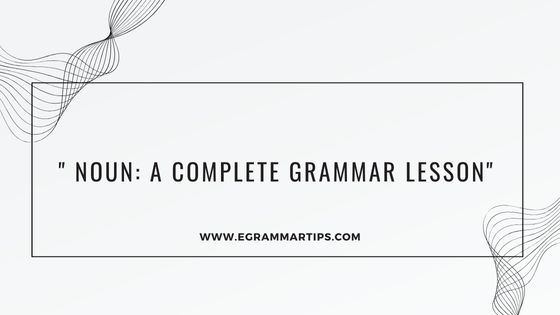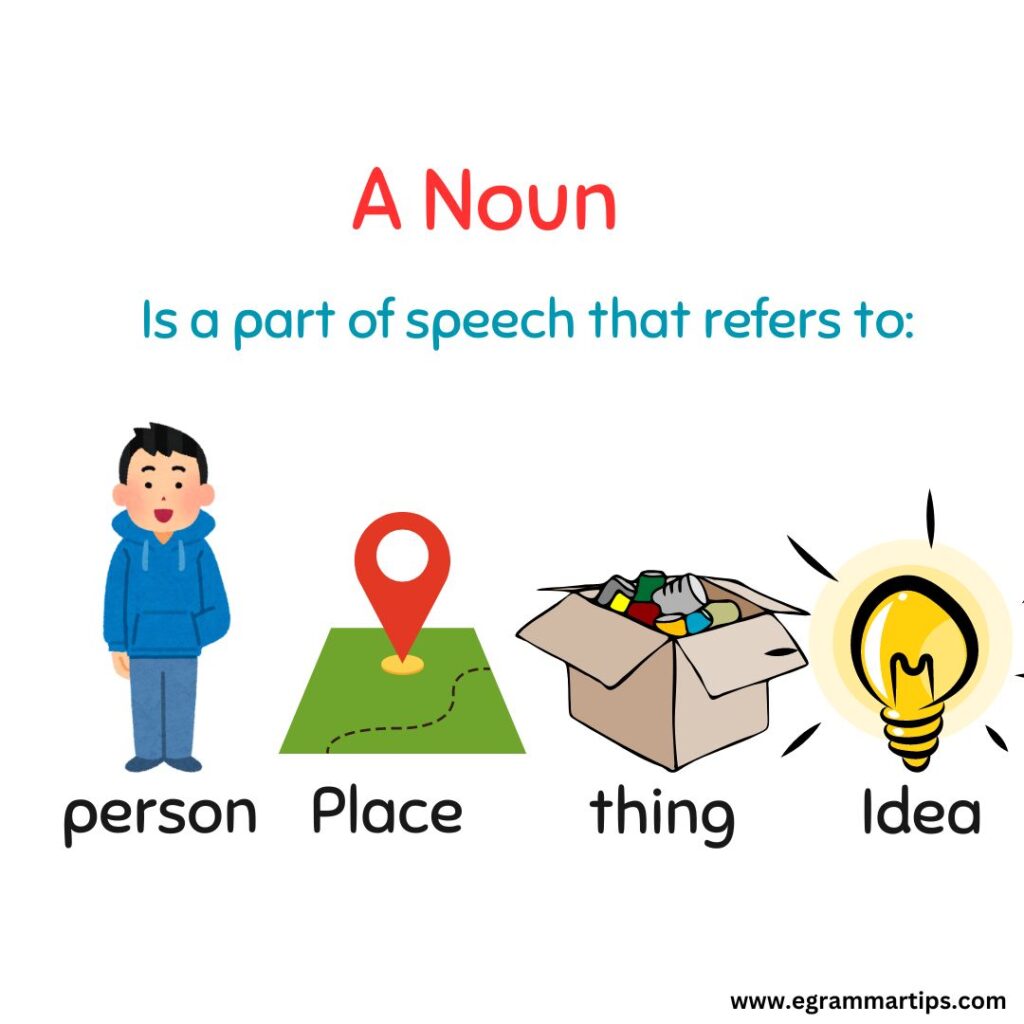
A noun is a word that names a person, place, thing, or idea. It is a fundamental part of speech in the English language, playing a crucial role in constructing sentences and conveying meaning. This lesson provides a comprehensive overview of nouns, covering their types, functions, and how they are used in sentences.

1. Definition and Importance of Nouns
A noun is traditionally defined as a word that identifies a person (e.g., “teacher”), place (e.g., “city”), thing (e.g., “book”), or idea (e.g., “freedom”). Nouns are essential because they are the main components of sentences. Without nouns, it would be impossible to clearly communicate who or what we are talking about.
2. Types of Nouns
Nouns can be categorized into several types based on their meaning and function:
•Common Nouns: These are general names for a person, place, or thing, such as “dog,” “city,” or “car.” They are not capitalized unless they start a sentence.
•Proper Nouns: These refer to specific names of people, places, or things and are always capitalized.Examples include “John,” “London,” and “Google.”
• Concrete Nouns: These refer to things that can be perceived with the senses, such as “apple,” “music,” or “dog.”
•Abstract Nouns: These are names of qualities, states, or ideas that cannot be seen or touched, such as “love,” “freedom,” or “happiness.”
•Collective Nouns: These refer to a group of people, animals, or things considered as one unit, like “team,” “flock,” or “family.”
•Compound Nouns: These are formed by combining two or more words to create a single noun, such as “toothpaste,” “mother-in-law,” or “notebook.”
•Countable and Uncountable Nouns: Countable nouns refer to things that can be counted (e.g., “book,” “apple”), and they have both singular and plural forms. Uncountable nouns refer to substances or concepts that cannot be counted (e.g., “water,” “information”) and usually do not have a plural form.
3. Functions of Nouns in Sentences
Nouns can serve various functions in a sentence:
•Subject: The noun that performs the action in a sentence (e.g., “The dog barks”).
•Object: The noun that receives the action of the verb. This can be a direct object (e.g., “She reads a book”) or an indirect object (e.g., “She gave the child a gift”).
•Object of a Preposition: Nouns can follow prepositions to form prepositional phrases (e.g., “The book is on the table”).
•Complement: Nouns can act as complements, providing additional information about the subject (e.g., “He is a teacher”).
4. Singular and Plural Forms
Nouns can appear in singular or plural forms, indicating one or more items, respectively:
•Regular Plurals: Most nouns form the plural by adding “-s” or “-es” (e.g., “cat” to “cats,” “box” to “boxes”). Nouns ending in “y” change the “y” to “i” and add “-es” if preceded by a consonant (e.g., “baby” to “babies”).
•Irregular Plurals: Some nouns have irregular plural forms that do not follow standard rules. For example, “child” becomes “children,” “foot” becomes “feet,” and “mouse” becomes “mice.”
5. Possessive Nouns
Possessive nouns show ownership or a relationship between things:
•Forming Possessives: For singular nouns, the possessive is formed by adding an apostrophe and “s” (e.g., “the cat’s toy”). For plural nouns that already end in “s,” only an apostrophe is added (e.g., “the dogs’ owner”). For plural nouns that do not end in “s,” an apostrophe and “s” are added (e.g., “the children’s books”).
•Double Possessives: Sometimes, both a possessive noun and “of” are used to indicate possession, as in “a friend of John’s.”
6. Noun Phrases
A noun phrase is a group of words that functions as a noun in a sentence. It typically includes a noun and its modifiers, which can be adjectives, determiners, or other descriptors:
•Example: In “The quick brown fox,” “The quick brown” is the modifier, and “fox” is the noun. Together, they form a noun phrase.
•Function: Noun phrases can serve as the subject, object, or complement in a sentence, providing more detail than a simple noun alone.
7. Proper Use of Nouns
Using nouns correctly involves understanding how they function in a sentence and how to modify them for clarity and precision:
•Capitalization: Proper nouns must always be capitalized, while common nouns are only capitalized at the beginning of sentences.
•Quantifiers and Articles: Nouns are often preceded by articles (“a,” “an,” “the”) and quantifiers (“some,” “many”) to provide more information about the noun.
•Agreement: Nouns must agree with their verbs and pronouns in number and gender, ensuring grammatical consistency in sentences.
8. Common Errors with Nouns
Some common mistakes involve noun usage, including:
•Incorrect Pluralization: Confusing regular and irregular plurals, such as using “childs” instead of “children.”
•Misusing Countable and Uncountable Nouns: Using incorrect quantifiers, like “much books” instead of “many books.”
•Improper Possessives: Misplacing apostrophes, as in “the cats toy” instead of “the cat’s toy” or “the cats’ toy” depending on context.
Nouns are an integral part of English grammar, serving as the names of people, places, things, and ideas. Mastery of nouns involves understanding their types, functions, and the rules for modifying them. Proper noun usage is essential for clear, effective communication, whether in writing or speaking. Understanding how to correctly use nouns, including forming plurals, possessives, and noun phrases, is a foundational skill in mastering the English language.